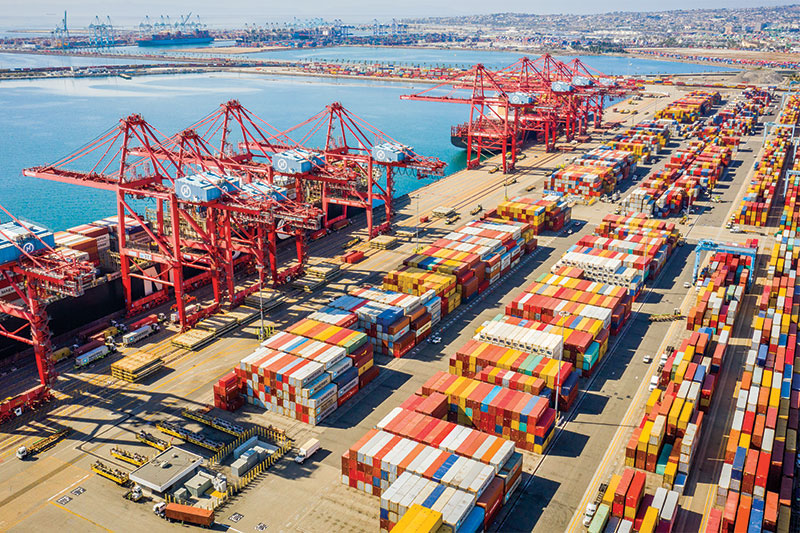Remember the seafarers
For it is here that the most glaring examples of port congestion are evident, with container vessels visible for miles anchored offshore waiting to enter major Pacific Rim cargo gateways.

From the Issue of
Logistics Management
With the advent of the holiday season and the relaxation of pandemic protocols, logistics managers may expect to witness a revival of industry events and a few quiet cocktail parties where they will reflect upon what it means to work on the U.S. West Coast.
For it is here that the most glaring examples of port congestion are evident, with container vessels visible for miles anchored offshore waiting to enter major Pacific Rim cargo gateways.
And while there has been much attention paid to how this historic gridlock is altering free markets and private enterprise, there has been scant reporting on the dire conditions for the working crews of these ships.
According to the Global Maritime Forum, there are approximately 1.6 million seafarers manning 50,000 commercial vessels currently operating around the world. Of these 1.6 million workers, about 230,000 of them—about 14.4%—are from the Philippines, making them the largest group among the world’s maritime workforce.
The International Chamber of Shipping estimates that most of them are affected by travel restrictions, either stuck at sea or unable to leave home to get to their ships.
Fortunately, the chamber says 12 countries have prioritized the push to vaccinate Filipino merchant crews, while ports in the United States are vaccinating all crews who arrive, irrespective of nationality.
And there has been other promising news of late. For example, more than 700 organizations and companies, from the World Economic Forum to BP and Shell, signed the Neptune Declaration on Seafarer Wellbeing and Crew Change this year. One call to action was declaring seafarers as “essential workers.” Sixty countries so far have done so.
Which brings us to appreciate the latest “Seafarers Happiness Index” report recently released by The Mission to Seafarers. Much of it suggests that COVID-19 related strains on seafarers are beginning to ease, and support measures for seafarer welfare have now had a chance to take effect.
Still, shore leave and extended contracts have been a huge challenge since the start of the pandemic. Five percent of seafarers responding said that they have been away at sea for over a year and a further 13% of respondents have served at sea for more than nine months, with the remainder reporting less than nine months—so far.
Filipino seafarers and their Pacific Rim brethren are stretched to the breaking point, and the effects are beginning to manifest themselves in a sharp rise in accidents, shipboard incidents among crews—even suicides.
Not surprisingly, the challenges of balancing home life with the uncertainties of working on cargo ships has led many seafarers accelerating their career change plans. Indeed, the report emphasizes that many of them are not intending to return to sea once they eventually get home.
The issue of retention in an already stressed workforce is a major concern. There is likely to be a growing shortfall in seafarers in the coming years, with seemingly little or no coherent mechanism to manage the problems coming over the horizon. The seafaring experience and expertise that is potentially going to be lost should serve as a warning to all.
“Seafarers have been through so much over the past two years,” says the reverend canon Andrew Wright, secretary general of The Mission to Seafarers. “They have been key to world trade at a time of unparalleled risk and disruption; they have kept the lights and heat on; they have kept shop shelves stocked and they have allowed the world to edge towards recovery. We owe them all a huge debt of gratitude and enormous respect and recognition.

Article Topics
Global Trade News & Resources
Maryland DOT: $1.9 billion and up to four years to rebuild bridge sunk near Baltimore port Baltimore suing ship that crashed into bridge, closing port, costing jobs UPS reports first quarter earnings decline Supply Chain Stability Index sees ‘Tremendous Improvement’ in 2023 Descartes March Global Shipping Report highlights ongoing steady volume momentum U.S.-bound import growth track remains promising, notes Port Tracker report EU Update 2024: Crises lead to growth More Global TradeLatest in Logistics
UPS announces CFO Newman to leave company, effective June 1 Preliminary April North American Class 8 net orders are mixed Senators take a close look at Amazon with Warehouse Worker Protection Act Despite American political environment, global geopolitical risks could be easing Maryland DOT: $1.9 billion and up to four years to rebuild bridge sunk near Baltimore port April Services PMI contracts after 15 months of growth, reports ISM 2023 industrial big-box leasing activity heads down but remains on a steady path, notes CBRE report More LogisticsAbout the Author
Subscribe to Logistics Management Magazine

Find out what the world's most innovative companies are doing to improve productivity in their plants and distribution centers.
Start your FREE subscription today.
May 2024 Logistics Management

Latest Resources














